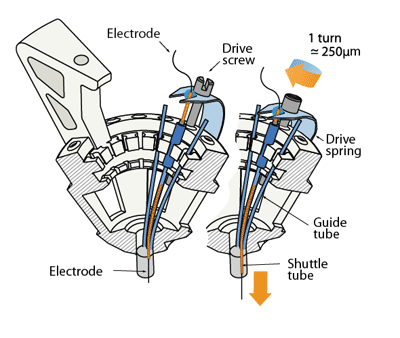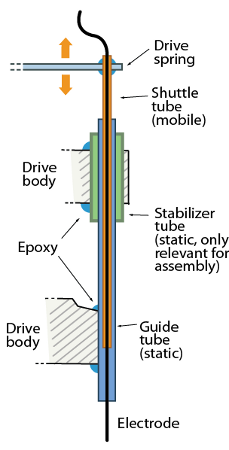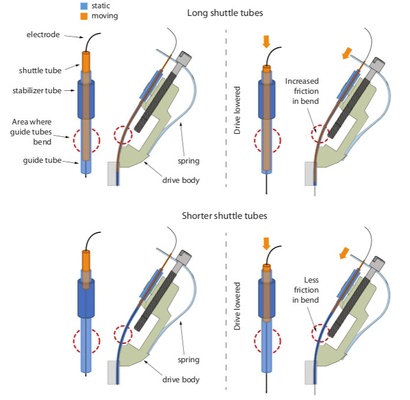(The picture shows the shuttle tube extending almost all the way through the guide tube - this can increase the friction of the drive and cause problems. It is often better to keep the shuttle tubes as short as possible, so they stop short of the bend in the guide tube when the drive is fully lowered.)
...
Depending on the quality of the 3d-print, finish the screw holes with #77 drill. Be careful to drill out the holes at the correct angle - with lower quality prints it is pretty easy to break through the inner wall of the drive body rim. Fitting a #77 drill bit into an ordinary electric drill might be a challenge. A keyless chuck (MCM Part #: 22-16500, Dremel Part #: 4486) can fit on a Dremel rotary tool, and holds even the finest drill bits.
Alternatively, the drill bit can be hold with a mini pin vise (MSC direct), than in turn will fit into an electric drill. It is worthwhile to test which drilling speed works best for each user - in some cases a higher speed tool such as a dremel can significantly simplify the drilling.
Alternatively, the drill bit can be hold with a mini pin vise (MSC direct), than in turn will fit into an electric drill. It is worthwhile to test which drilling speed works best for each user - in some cases a higher speed tool such as a dremel can significantly simplify the drilling.
The slots along the inside perimter of the drive body may have to be finished with a #77 drill or razor blade if the print quality is low–they must be large enough to allow the 33ga polyimide tubing through.
Clean off plastic dust with compressed air, water, or ethanol, be careful when using ethanol as it will weaken the plastic when exposed for too long.
...
(The picture shows the shuttle tube extending almost all the way through the guide tube - this can increase the friction of the drive and cause problems. It is often better to keep the shuttle tubes as short as possible, so they stop short of the bend in the guide tube when the drive is fully lowered.)
(optional) Map out the relationship between guide tubes at the drive bottom and the recently-glued guide tubes at the top of the drive by inserting a thin wire or spare tetrode into the guide tubes one at a time.
...
Insert shuttle tubes into guide tubes so that they are inserted ~1mm at the most retracted position. This minimizes the length of the shuttle tubes that is inside the guide tubes - if that length is too long, it increases friction. Keep in mind the spring arms are halfway through their range of motion so make sure to account for how much further the screws could be retracted. If the shuttle tubes are so long as to reach the 'bend' at the bottom of the guide tubes, this can cause problems if the sizing of the tubes is tight - avoid this if possible. If the shuttle tubes are too short they can be accidentally removed from the ends of the guide tubes later on. Glue See the image below for a schematic of how this shorter shuttle tube can reduce the friction:
Next, glue shuttle tube to spring arm; it is often easiest to do this in one of the corners of the spring arm but any stable location on the spring should work okay. If the shuttle tube doesn't naturally rest against the spring arm, attach it with a tiny bit of super glue before applying epoxy. Superglue alone will not hold the tube to the spring arm! Apply a generous amount of epoxy while avoiding the inside of the tubes and the screw, you can use two layers of epoxy for added stability.
...



